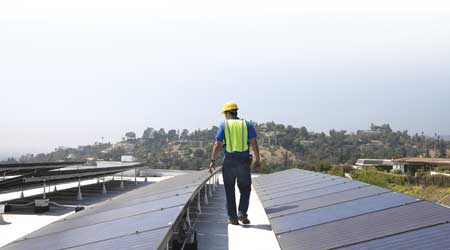Sustainability Roofing Push Leads to Photovoltaic Systems
Part three of a 3-part article on common roofing problems
The push toward sustainable building practices has led design professionals to look at roofs as more than just providing weather resistance. They view the roof as space for renewable energy sources, such as PV systems. While PV systems help the environment and building owner, their impact on membrane performance is an important issue. Due to its inherent durability, bituminous membrane roofing is well-suited as a platform for PV systems, if the parties practice proper design, installation and maintenance.
When installers use proper precautions and protective equipment, PV systems go on safely and without incident. Areas requiring attention include these:
Fall hazards. Working at heights can be dangerous. Installers must follow all necessary precautions, safety guidelines and U.S. Occupational Safety and Health Administration regulations in conjunction with proper roofing-trade practices, including the use of appropriate fall-protection and fall-arrest equipment.
Shock and electrocution hazard. PV modules generate electric current. Installers and maintenance workers must observe safe electrical practices at all times. They also must comply with local codes and National Electrical Code requirements, as well as the manufacturer’s installation instructions and cautionary recommendations.
Proper installation is critical. Not only must the PV system be installed according to the manufacturer instructions, but any contact, adhesion, or penetration of the roof assembly by the PV system must be in accordance with manufacturer recommendations. If the specific roofing manufacturer is unknown, installers should follow generally accepted roofing practices.
In evaluating modules, managers should refer to applicable codes and standards, such as: ICC-ES AC365; IEC 61646 Edition 2.0, 2005-05; IEC International Standard, Thin-Film Terrestrial Photovoltaic (PV) Modules – Design qualification and type approval; NRCA’s Guidelines for Roof-mounted Photovoltaic System Installations; and NEC Article 690.
To maximize the service lives of the PV and roof membrane systems, PV systems should be installed in conjunction with a new roof membrane system. If managers are considering having the PV system installed over an existing roof, they should consult with a roofing professional to evaluate the membrane’s age and condition.
The roof membrane might absorb additional heat when building-integrated PV panels are adhered to the membrane due to their dark color, combined with the generated heat. Increased heat load and life expectancy of roofing systems generally are inversely proportional, and at elevated temperatures, commercial roof membrane systems will suffer from accelerated aging. Managers should carefully plan and execute the addition of materials to the roof system that elevate its surface temperature.
Before installing a PV system, have a licensed structural engineer inspect the roof structure to ensure the building can support the dead, wind, and seismic loads imposed by the PV system.
Consult the roofing system manufacturer for the minimum allowable slope for its membrane product. Proper drainage will help minimize accumulation of dirt and debris under the PV system.
Managers need to ensure that the design maintains positive roof drainage. Altering the rate and direction of water flow intended in the original design might cause dirt and debris to build up around the obstructions and accelerate membrane deterioration.
Roof-mounted PV systems may be installed using a rack-mounted, ballasted, or adhesive method. Managers must be sure installers carefully read and follow the PV system manufacturer’s instructions.
Contact the roofing manufacturer for installation and waterproofing best practices and for recommendations for construction details and their installation affecting the membrane system. Before PV system installation, managers also should contact the manufacturer for recommended practices to protect the system. When planning the location of rooftop PV panels, consult with the PV manufacturer for guidelines while considering wind- and fire-resistance requirements.
To ensure comprehensive post-installation maintenance, managers should consult with the manufacturers of the PV, racking — if applicable — and roofing system for recommended inspection and maintenance programs.
The Asphalt Roofing Manufacturers Association — www.asphaltroofing.org — provided information for this article.
Related Topics:














